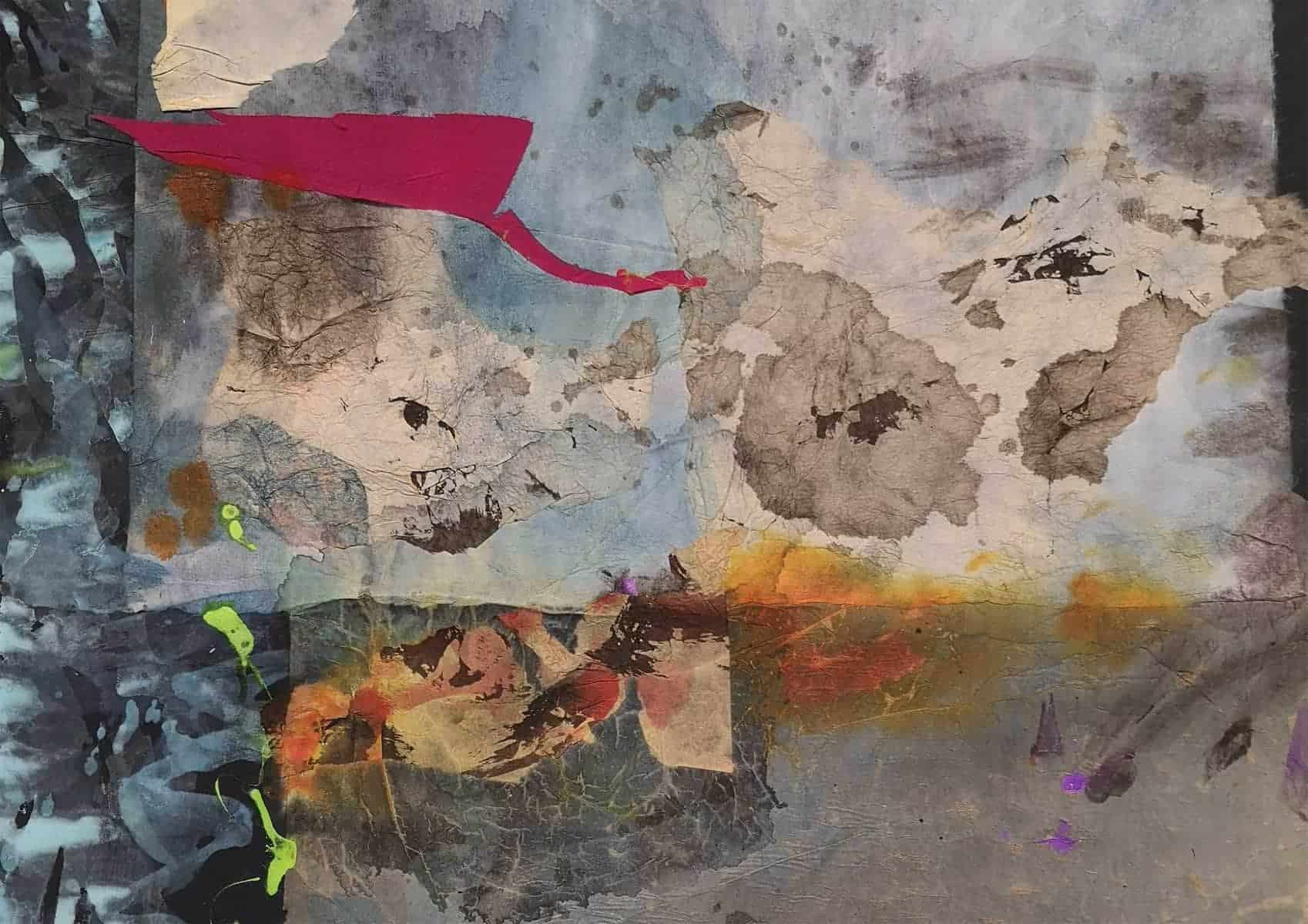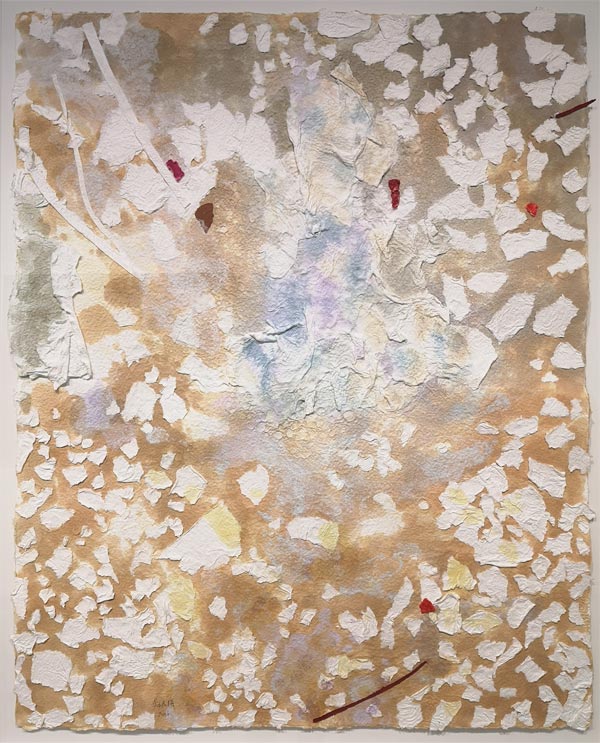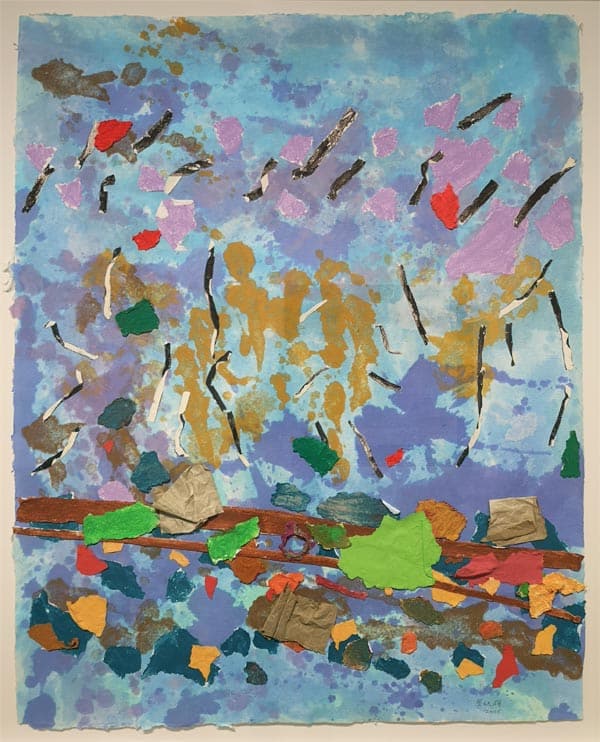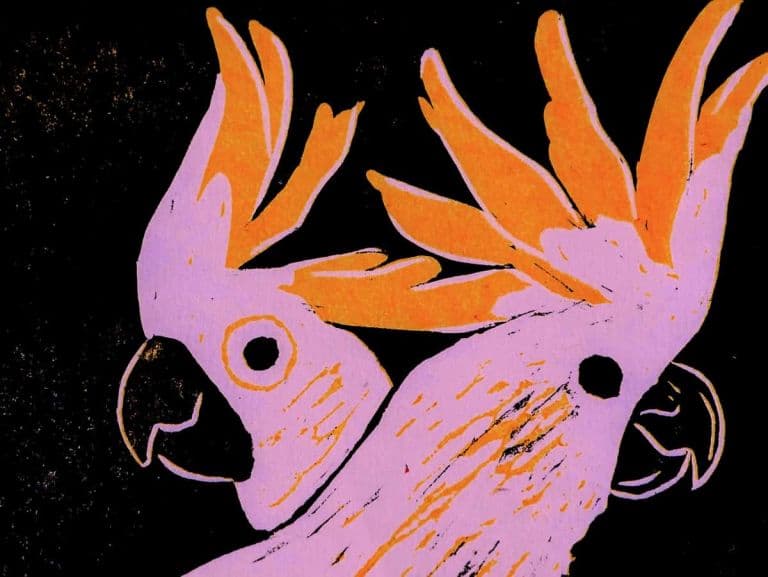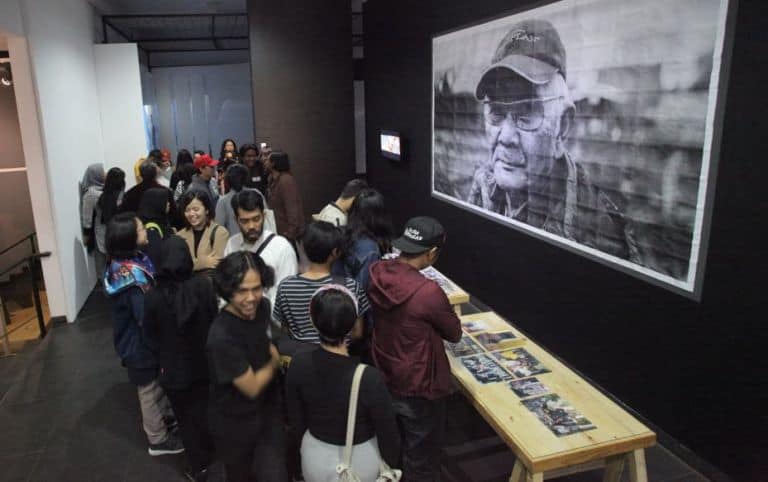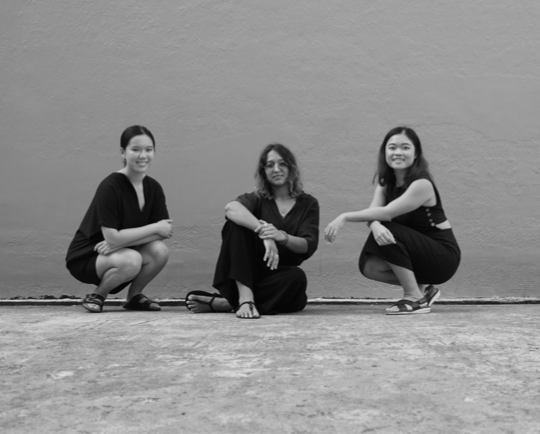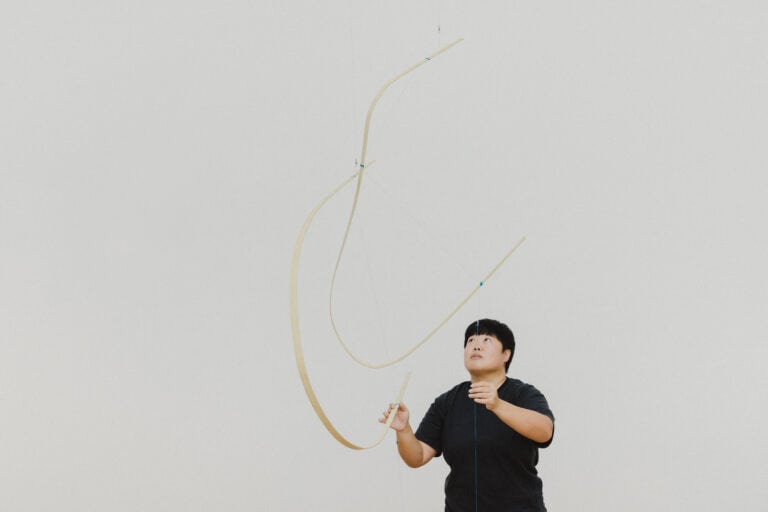The STPI – Creative Workshop & Gallery (STPI) annual special exhibition Shaping Visions, features the works of five luminaries of the local art scene – Chua Ek Kay, Goh Beng Kwan, Han Sai Por, Amanda Heng and Ong Kim Seng. That all five are recipients of the Cultural Medallion, an award widely recognised to be the highest award conferred to a Singaporean for their achievements in the arts, should be sufficient draw for any art enthusiast to pay a visit.
A Chance to Compare Cultural Medallion Artists’ Usual Practices and Paper-Based Works
This exhibition includes works from the maestros’ usual practice alongside the paper-based works that they created during their respective residencies at STPI. These adjacent presentations inevitably invite the viewer to compare these works, and in doing so, notice subtleties in differences and similarities both in style and subject matter.
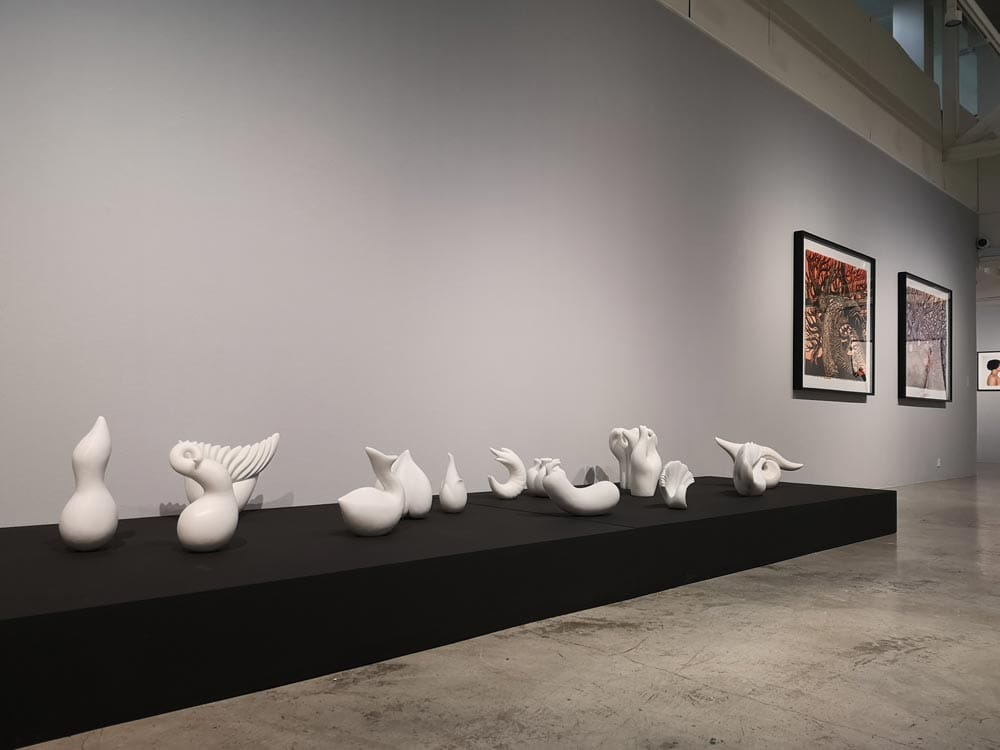
One first encounters the stark disparity between Han Sai Por’s sculptural works and her woodblock prints in the central gallery. Curling and unfolding, the diminutive forms of the marble works from her Flora series exude a quiet presence, each taking up a self-contained space on the raised black platform at calf height. One has to squat in order to inspect them more closely, suggesting that Man must make some effort to accommodate Nature.
In contrast, Rooted 4 and Nestles 4 embody the wilder, more menacing side of nature. Gnarly branches threaten to extend beyond the four edges of the picture plane and engulf the viewer. Though all of Han’s works address the theme of nature, her expressions on paper are wrought from stark, bold marks against a vibrant background, as if the artist is creating a sense of the sculptural on a two-dimensional surface.
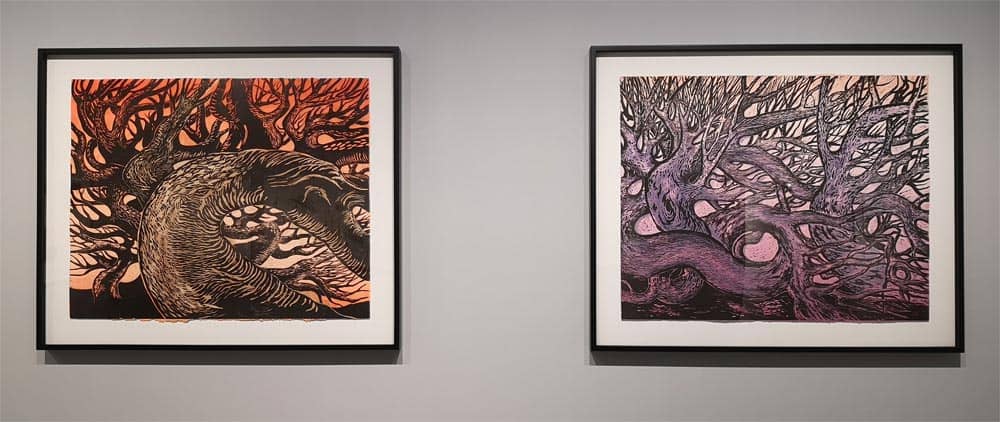
Across from Han’s works in the central gallery, the delicate yet lively strokes of Chua Ek Kay adorn both his paintings as well as his paper pulp works. Nature thrums with joyful energy in works such as Dance With the Morning Breeze. Here, Chua creates a flurry of momentum with strokes that cut across ambiguous negative space.
It is difficult to tell which of Chua’s works are prints and which are paintings. His ink and pigment works such as Lotus Pond By Night possess the same deft strokes as his pigmented paper pulp works and lithographs such as Intimate Space of Silence and Reflections on the Lotus Pond. Regardless of medium, it’s clear that the artist’s regard for nature’s poeticism permeates throughout his practice. With masterful flicks of the brush, Chua conveys the lyrical beauty of the lotus pond in his expressionistic, semi-abstracted scenes.
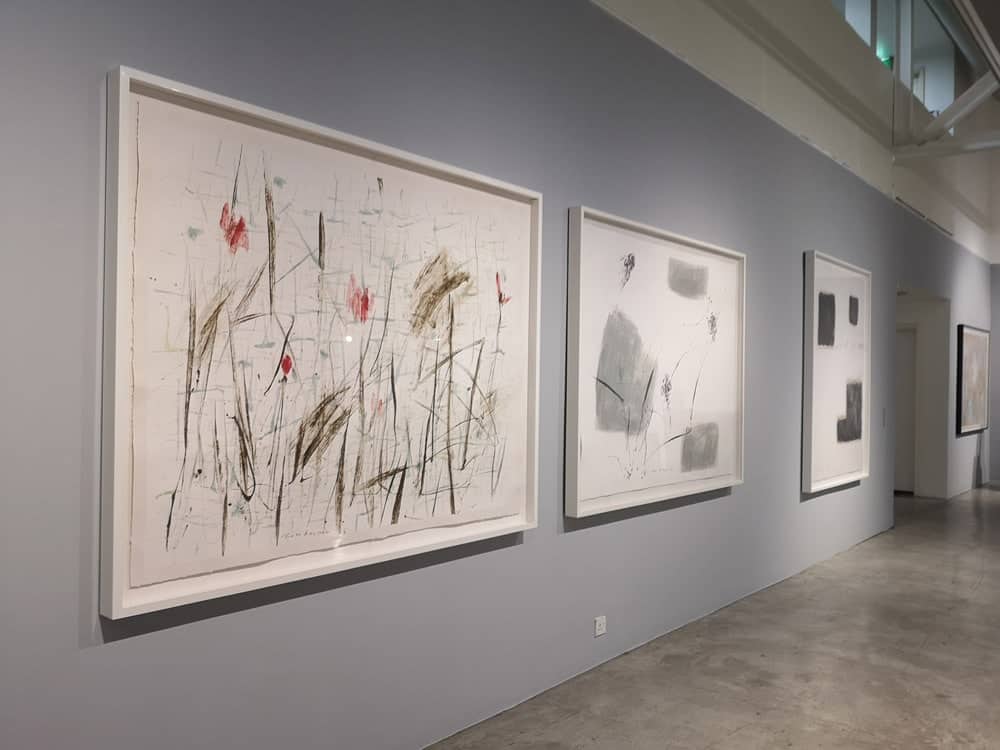
A Preoccupation with Textures
Perhaps what’s important is not whether one is able to tell between artistic mediums, but the ability to appreciate, up close, the sumptuous textures embedded on the surface of each work. The moments of scarlet that adorn Dance With the Morning Breeze possess both a sense of romance and violence in the way that they’ve been rouged onto the surface – an occasional brush here and there to catch the eye, as flowers do in a sea of leaves and ripples.
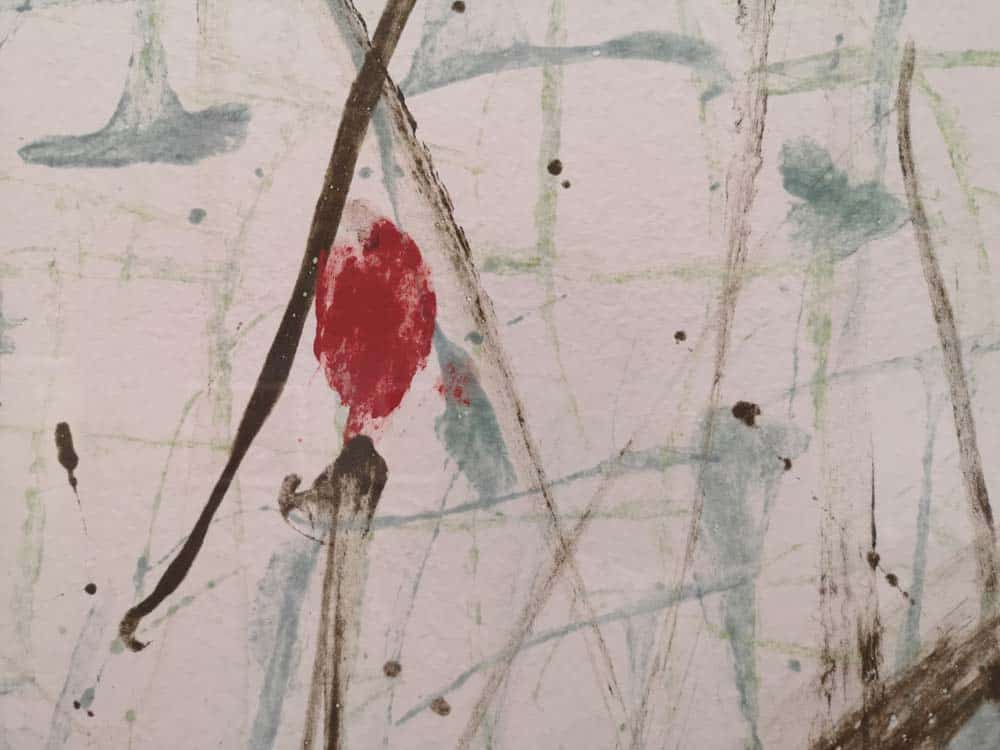
This obsession with the subtleties of textures possesses me mid-way through my visit, and I find myself drawn to the moments in which my eye falls upon a work and won’t let go.
Moving towards one side of the gallery, one encounters Goh Beng Kwan’s One Tree Hill, a mixed media collage teeming with visual interest. From hot pink paper scrap to neon green and metallic purple paint flecks, the surface of this work is variously animated with a range of material and marks. I found it to be a mesmerising mix. Here is a detail shot of Goh Beng Kwan’s One Tree Hill, though it’s better up-close and unmediated by the screen, so do make a visit to see it for yourself.
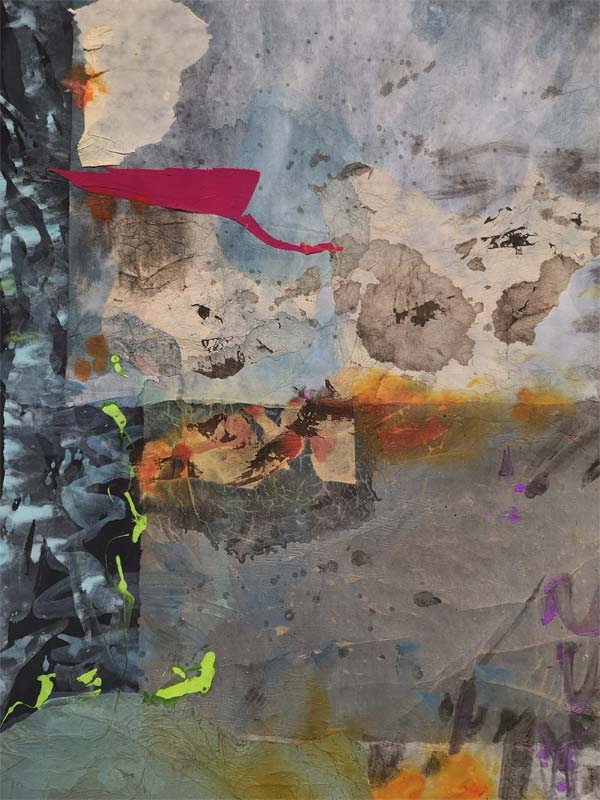
Several of Goh’s other collage works pepper this side of the gallery, culminating in two large works that he had created during his residency at STPI. The Summer is Over and Dancing Stripe both feature his signature collage aesthetic, but the means by which they are created is a little different. He collaborates with gravity and chance through the water-based process that these paper pulp collages involve. Tearing and placing pieces of paper pulp into a paper-making mould that has been submerged in water, the pieces move and settle as water is drained from the porous mould to eventually take their places as you see them in the work.
Variances in Emotional Expression in the Masters’ Works
According to curator Rachel Tan, Goh’s works are often keyed into his personal emotional history, or reflect his psychological traits and values. For instance, Rock Island was said to be born from Goh’s inner turmoil during a time when his wife was ill. The resultant expressionistic works thus translate the feelings from which they were born into open-ended abstractions.
In contrast, the moods that permeate watercolourist Ong Kim Seng’s portraits of Singapore are apparent from the get-go. They are variously exuberant and nostalgic, depending on Ong’s choice of colours and subject matter. On one wall hangs a series of quiet portraits of a Singapore on its journey of modernisation. In Morning Arrival and Container Northbound, trains cut through lush tropical terrain, and Ong’s skill of suffusing realism with poeticism is at its height here.
Curiously enough, they were painted within the past decade, in 2011. Ong transports us all to simpler moments of the nation’s past through his act of painting these scenes, and introduces a contemplative pause into our too-often harried lives. The earthy, naturalistic tones reinforce the serene mood in this series, and keep it close to nature.
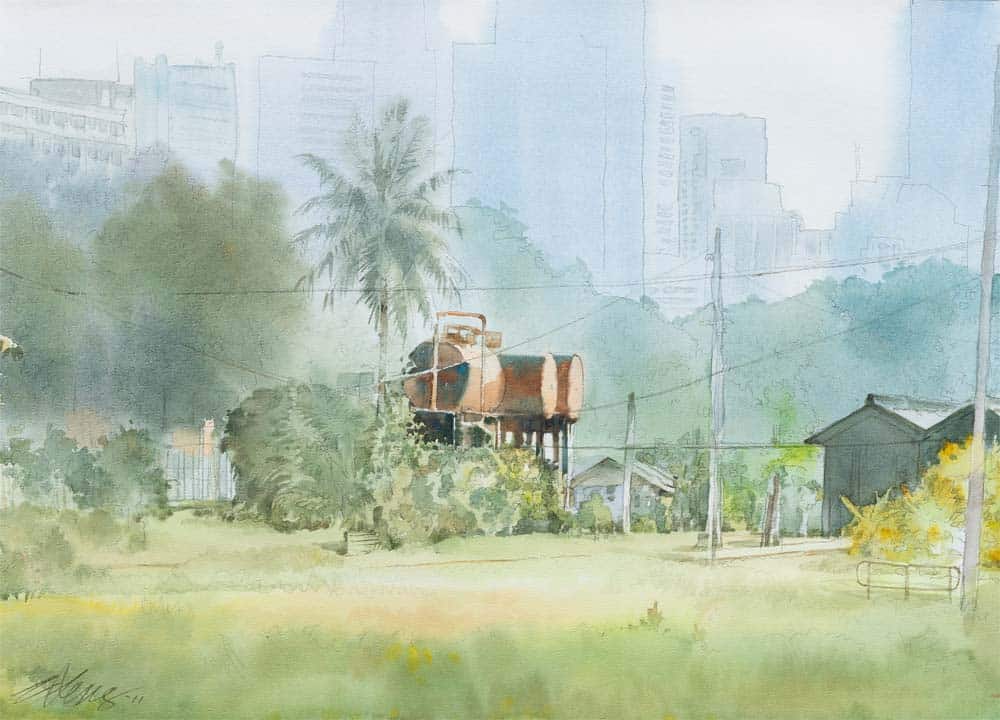
In contrast, the works on the opposing wall utilise a more vibrant and exuberant palette that is distinctly different from Ong’s usual oeuvre. This aesthetic arose out of his experimentation with the style of the West Coast American watercolourists of the mid-1920s.
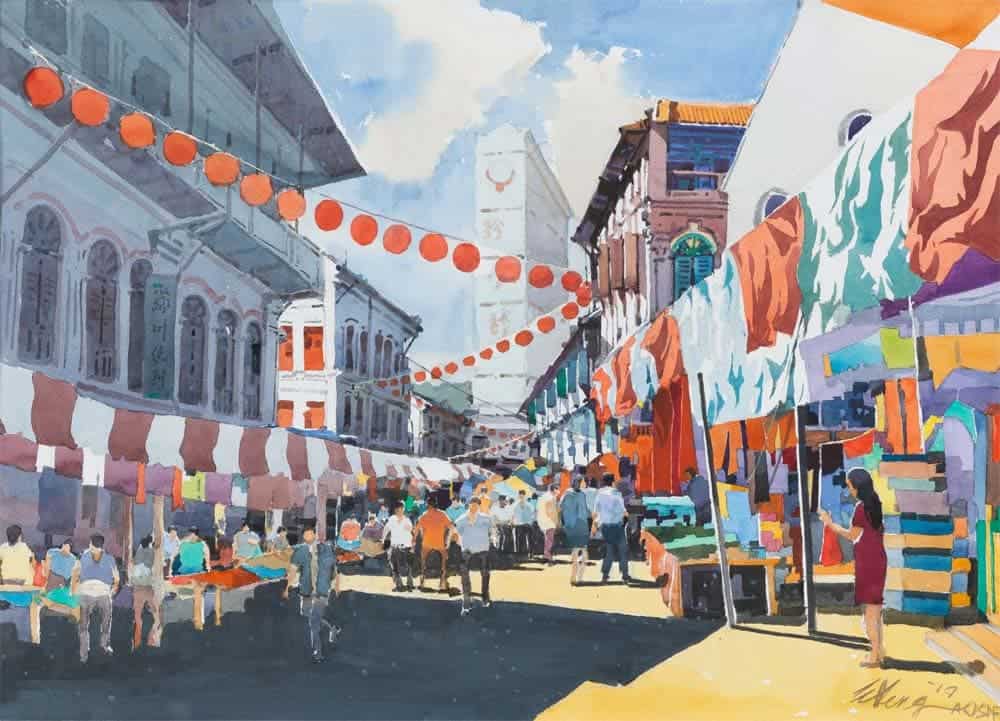
Riotous shades of orange and red lend works such as Temple Street (California Style Series) a warmth that not only suggests the literal heat of the tropics, but also the excitement of being in a bustling city. By choosing a darker shade of blue to fill the sky in From National Gallery (California Style Series), Ong further crowds an already full composition. That sense of claustrophobic city life is thus fully conveyed.
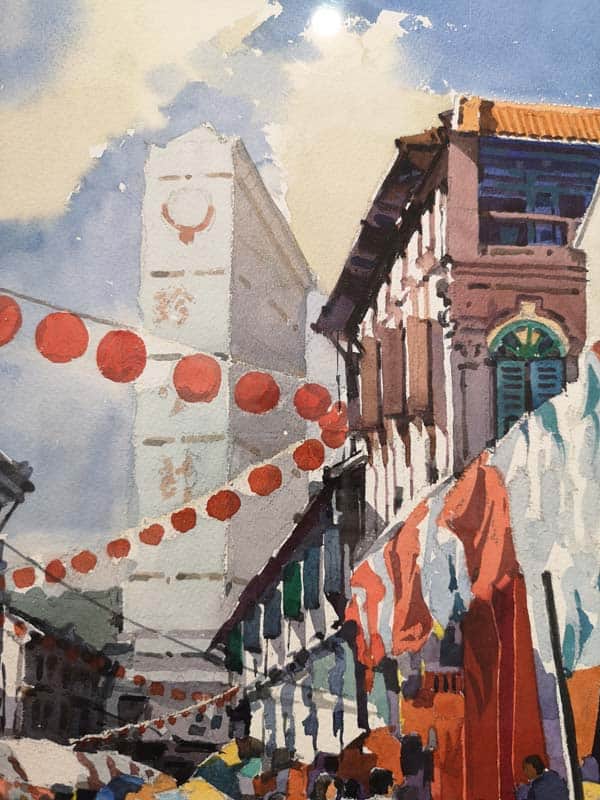
Placed in conversation with one another on opposing walls, the showcasing of the artist’s different styles parallels the revealing of Singapore’s contrasting sides. On one hand, the forgotten corners of Singapore, quiet, bleary-eyed, yet to be overrun by the relentless march of progress; and on the other, a colourful, idyllic city of the tropics.
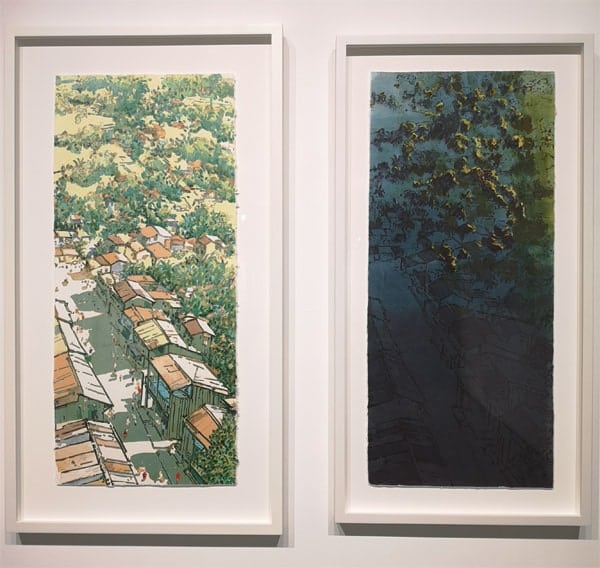
Society as Environment
While most of the works in the gallery focus on the natural and built environment as subject matter, a series of intimate photographic portraits lines the back wall of the gallery prominently. It is Amanda Heng’s Another Woman series, which she undertook with her mother in an effort to reconnect with her despite the generational rift caused by differences in values and language. Heng’s work explores how one’s environment is shaped as much by its people as its spaces. The works in this series are alternately tense and tender, typifying the fraught relations between mother and daughter.
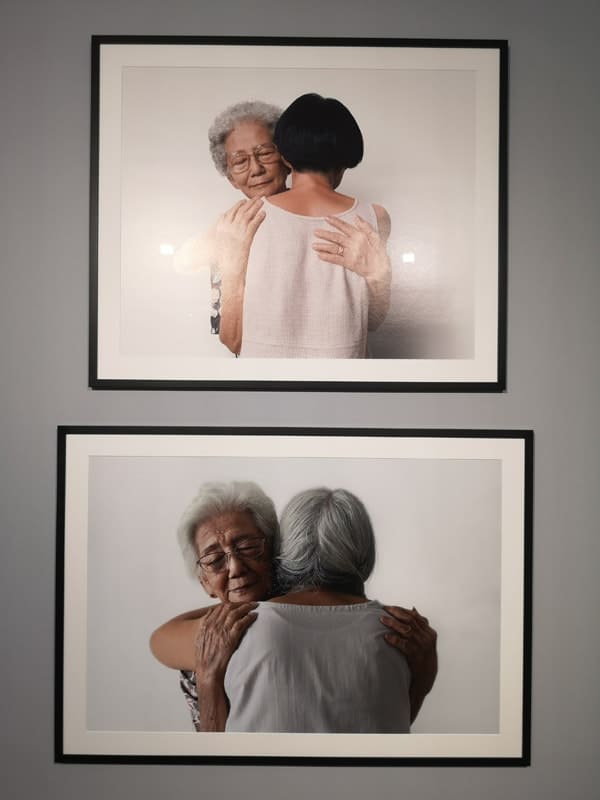
Elsewhere, she continues to explore the nature of human relationships and memories. For her STPI residency in 2016, Heng extended her pioneering participatory performance Let’s Chat by inviting twelve collaborators to chat with her whilst cleaning bean sprouts. Over the conversation, collaborators shared their personal stories, ideas and narratives, which Heng then translated into the multi-part visual and multimedia works that became part of this series of works.
Shaping Visions includes two works from this series, which were created with collaborators with Haruka Hikita and KC Poh. The collaboration with Haruka Hikita includes a collage of personal reflections, recipes and drawings that “centred on her idea of independence and interdependence during a time of migrating from country to country and experiencing cultural dislocation,” as the curator puts it.
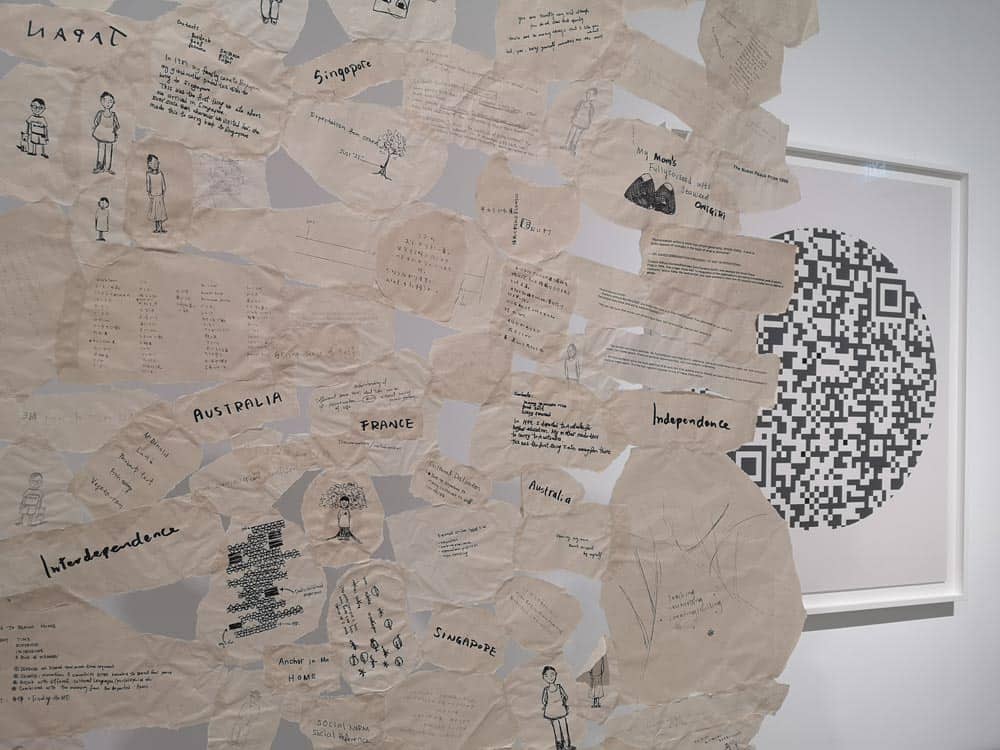
The QR codes in the works each lead to digital extensions that provide a different entry point into the narratives presented in the printed art. In this unlikely way, they also connect to the present COVID-19 pandemic where QR codes have become the gatekeepers of our public spaces, creating an unexpected resonance of this common sigil across time.
These days, it’s possible to view everything through the screen, and this exhibition is no exception. But whether it’s the promise of the works of five luminaries that has drawn your interest, or just a general need to get out of the house in these troubled times, there is something for just about everyone in this show. For those of us for whom the nuances of texture, form and scale are what makes art come alive, I’d especially encourage a trip to the gallery in person. The layered intricacies of these works on paper – whether print, collage, or painting – especially at the hands of these master artists – are such that you’ll find that your effort well rewarded.
________________________________________________________________
Shaping Visions is ongoing from now until 15 November 2020 at STPI.
This article is produced in paid partnership with STPI. Thank you for supporting the institutions that support Plural.
